Management and Operations: Manager and Leader Roles Report
VerifiedAdded on 2020/10/22
|10
|2749
|364
Report
AI Summary
This report delves into the core differences between managers and leaders within an operational context, using Amazon as a case study. It examines the distinct duties and attributes of managers, focusing on planning, organizing, directing, staffing, and controlling. It contrasts these with the roles of leaders, which include setting objectives, motivation, and training. The report further analyzes how managers and leaders adapt their roles in various situations, such as during periods of slow or rapid change, and explores different leadership theories, including situational, system, and contingency leadership. The analysis highlights the similarities between the two roles, emphasizing their shared goal of achieving organizational objectives effectively and efficiently. The report concludes with an overview of scientific and trait theories of management and leadership.
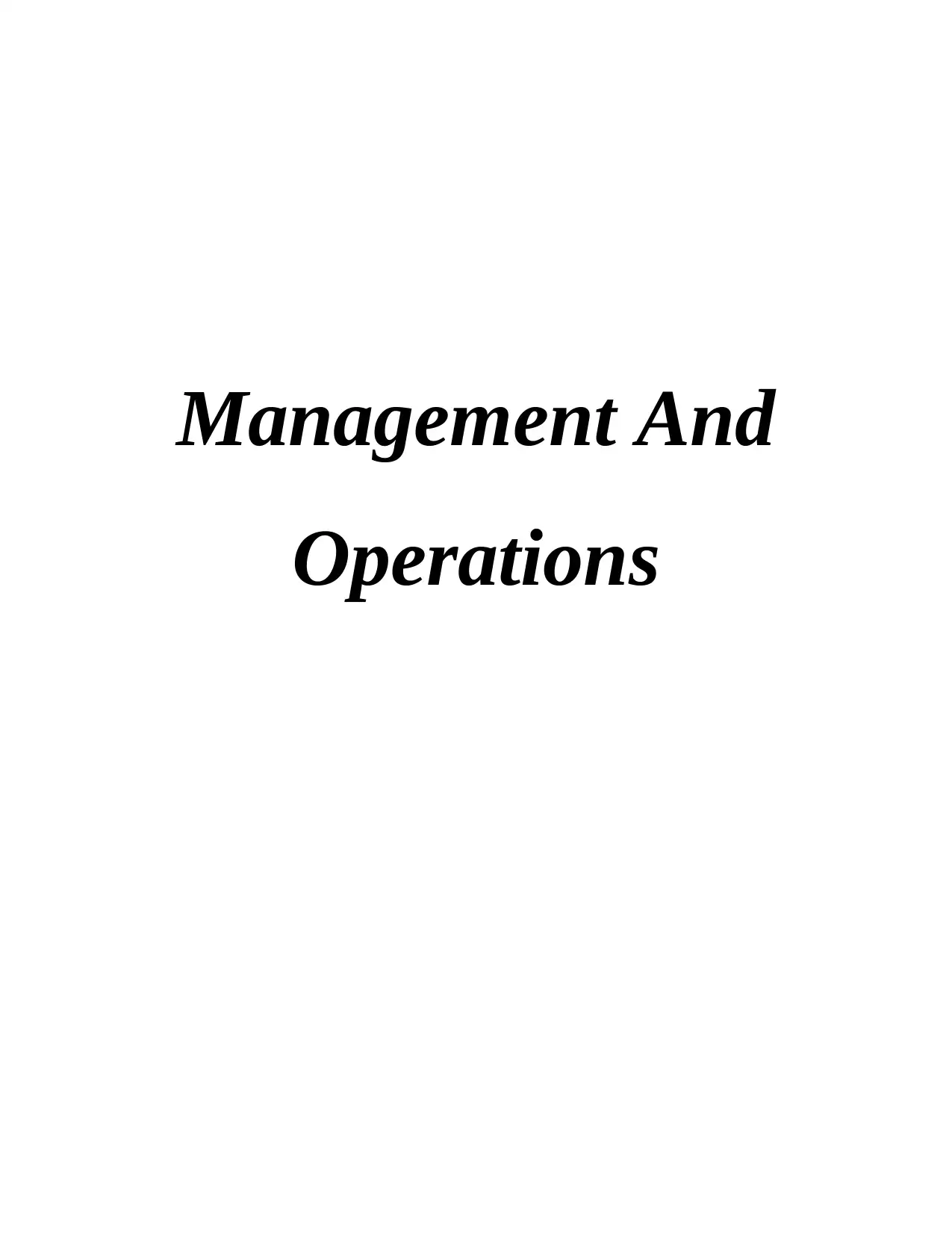
Management And
Operations
Operations
Paraphrase This Document
Need a fresh take? Get an instant paraphrase of this document with our AI Paraphraser
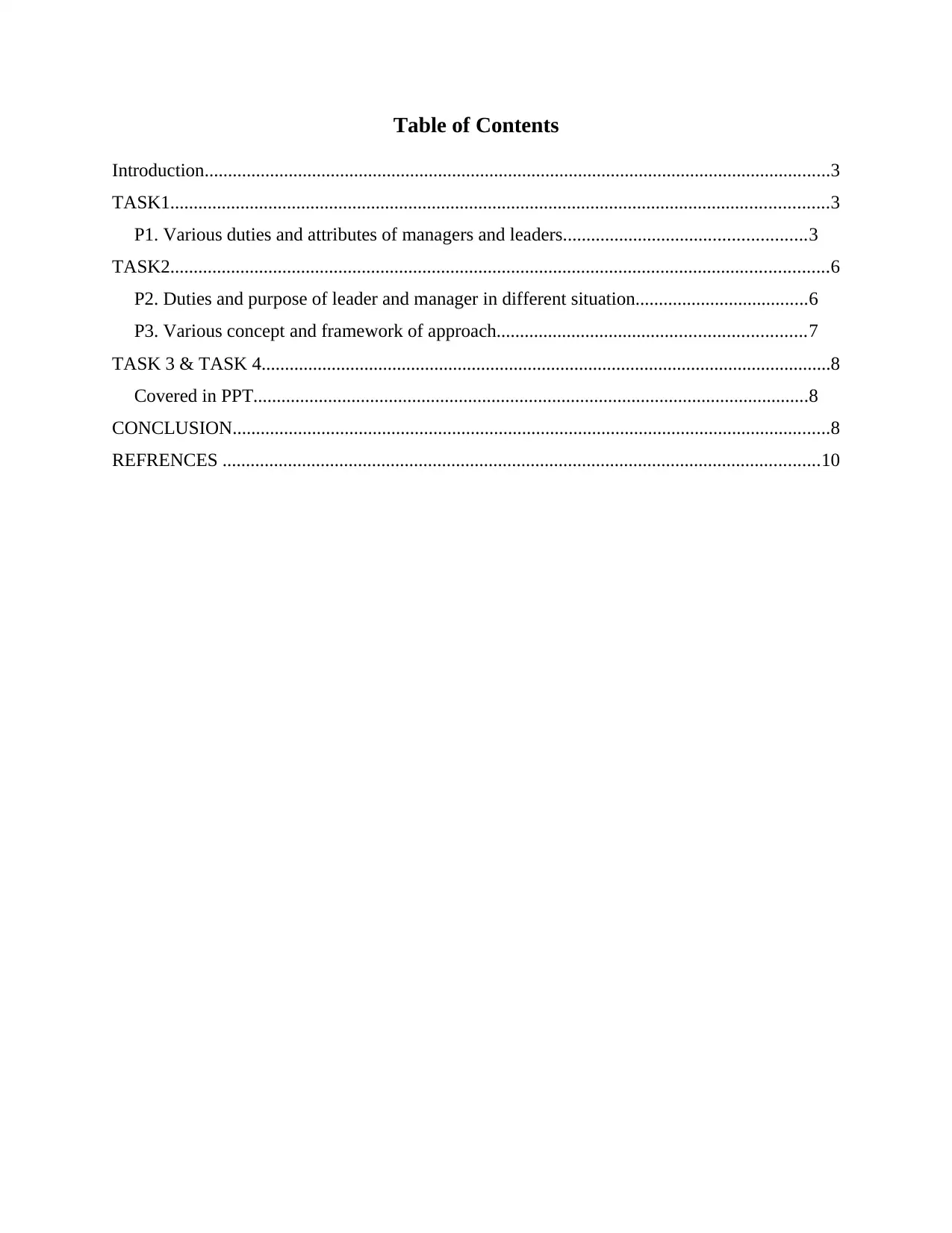
Table of Contents
Introduction......................................................................................................................................3
TASK1.............................................................................................................................................3
P1. Various duties and attributes of managers and leaders....................................................3
TASK2.............................................................................................................................................6
P2. Duties and purpose of leader and manager in different situation.....................................6
P3. Various concept and framework of approach..................................................................7
TASK 3 & TASK 4..........................................................................................................................8
Covered in PPT.......................................................................................................................8
CONCLUSION................................................................................................................................8
REFRENCES ................................................................................................................................10
Introduction......................................................................................................................................3
TASK1.............................................................................................................................................3
P1. Various duties and attributes of managers and leaders....................................................3
TASK2.............................................................................................................................................6
P2. Duties and purpose of leader and manager in different situation.....................................6
P3. Various concept and framework of approach..................................................................7
TASK 3 & TASK 4..........................................................................................................................8
Covered in PPT.......................................................................................................................8
CONCLUSION................................................................................................................................8
REFRENCES ................................................................................................................................10
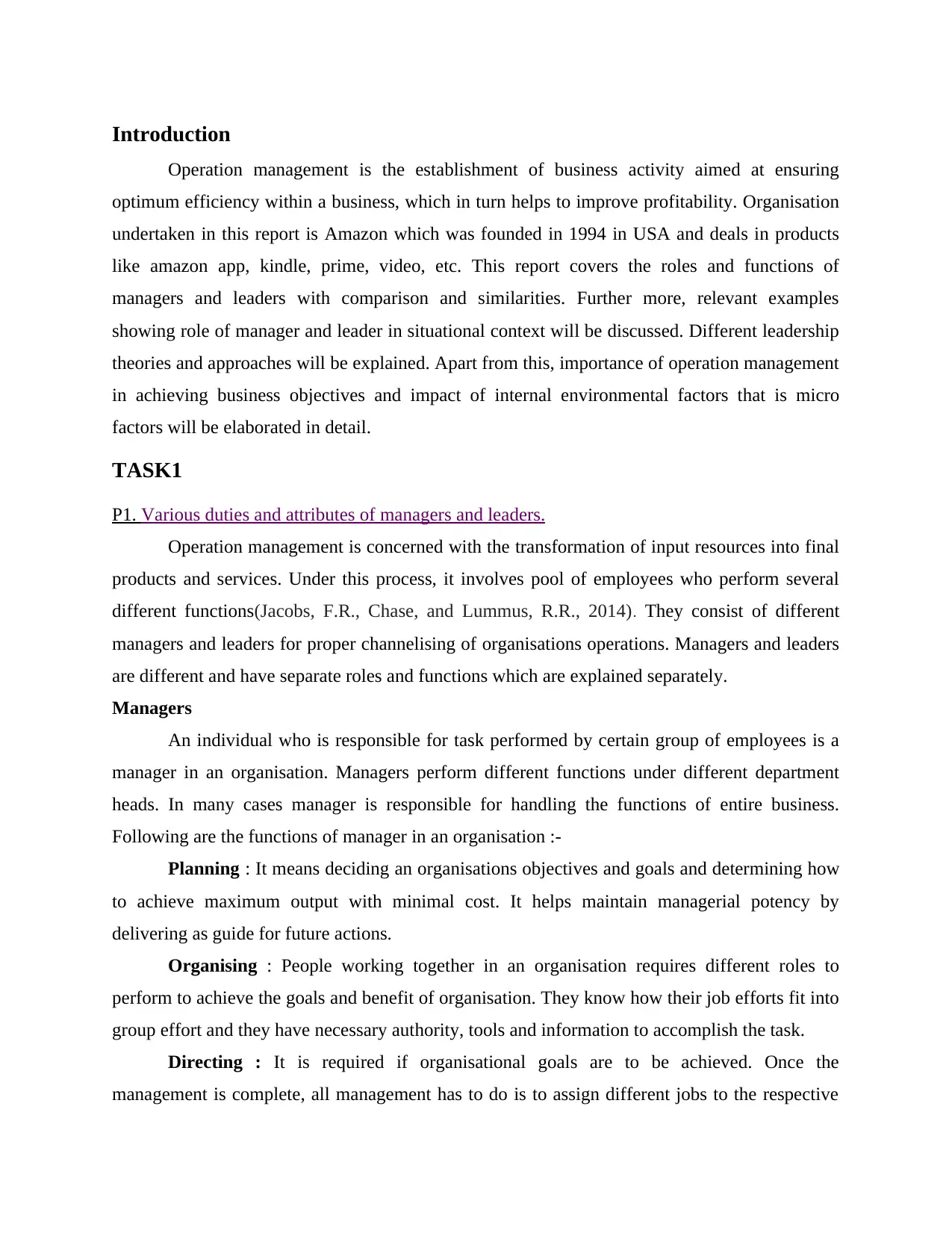
Introduction
Operation management is the establishment of business activity aimed at ensuring
optimum efficiency within a business, which in turn helps to improve profitability. Organisation
undertaken in this report is Amazon which was founded in 1994 in USA and deals in products
like amazon app, kindle, prime, video, etc. This report covers the roles and functions of
managers and leaders with comparison and similarities. Further more, relevant examples
showing role of manager and leader in situational context will be discussed. Different leadership
theories and approaches will be explained. Apart from this, importance of operation management
in achieving business objectives and impact of internal environmental factors that is micro
factors will be elaborated in detail.
TASK1
P1. Various duties and attributes of managers and leaders.
Operation management is concerned with the transformation of input resources into final
products and services. Under this process, it involves pool of employees who perform several
different functions(Jacobs, F.R., Chase, and Lummus, R.R., 2014). They consist of different
managers and leaders for proper channelising of organisations operations. Managers and leaders
are different and have separate roles and functions which are explained separately.
Managers
An individual who is responsible for task performed by certain group of employees is a
manager in an organisation. Managers perform different functions under different department
heads. In many cases manager is responsible for handling the functions of entire business.
Following are the functions of manager in an organisation :-
Planning : It means deciding an organisations objectives and goals and determining how
to achieve maximum output with minimal cost. It helps maintain managerial potency by
delivering as guide for future actions.
Organising : People working together in an organisation requires different roles to
perform to achieve the goals and benefit of organisation. They know how their job efforts fit into
group effort and they have necessary authority, tools and information to accomplish the task.
Directing : It is required if organisational goals are to be achieved. Once the
management is complete, all management has to do is to assign different jobs to the respective
Operation management is the establishment of business activity aimed at ensuring
optimum efficiency within a business, which in turn helps to improve profitability. Organisation
undertaken in this report is Amazon which was founded in 1994 in USA and deals in products
like amazon app, kindle, prime, video, etc. This report covers the roles and functions of
managers and leaders with comparison and similarities. Further more, relevant examples
showing role of manager and leader in situational context will be discussed. Different leadership
theories and approaches will be explained. Apart from this, importance of operation management
in achieving business objectives and impact of internal environmental factors that is micro
factors will be elaborated in detail.
TASK1
P1. Various duties and attributes of managers and leaders.
Operation management is concerned with the transformation of input resources into final
products and services. Under this process, it involves pool of employees who perform several
different functions(Jacobs, F.R., Chase, and Lummus, R.R., 2014). They consist of different
managers and leaders for proper channelising of organisations operations. Managers and leaders
are different and have separate roles and functions which are explained separately.
Managers
An individual who is responsible for task performed by certain group of employees is a
manager in an organisation. Managers perform different functions under different department
heads. In many cases manager is responsible for handling the functions of entire business.
Following are the functions of manager in an organisation :-
Planning : It means deciding an organisations objectives and goals and determining how
to achieve maximum output with minimal cost. It helps maintain managerial potency by
delivering as guide for future actions.
Organising : People working together in an organisation requires different roles to
perform to achieve the goals and benefit of organisation. They know how their job efforts fit into
group effort and they have necessary authority, tools and information to accomplish the task.
Directing : It is required if organisational goals are to be achieved. Once the
management is complete, all management has to do is to assign different jobs to the respective
⊘ This is a preview!⊘
Do you want full access?
Subscribe today to unlock all pages.

Trusted by 1+ million students worldwide
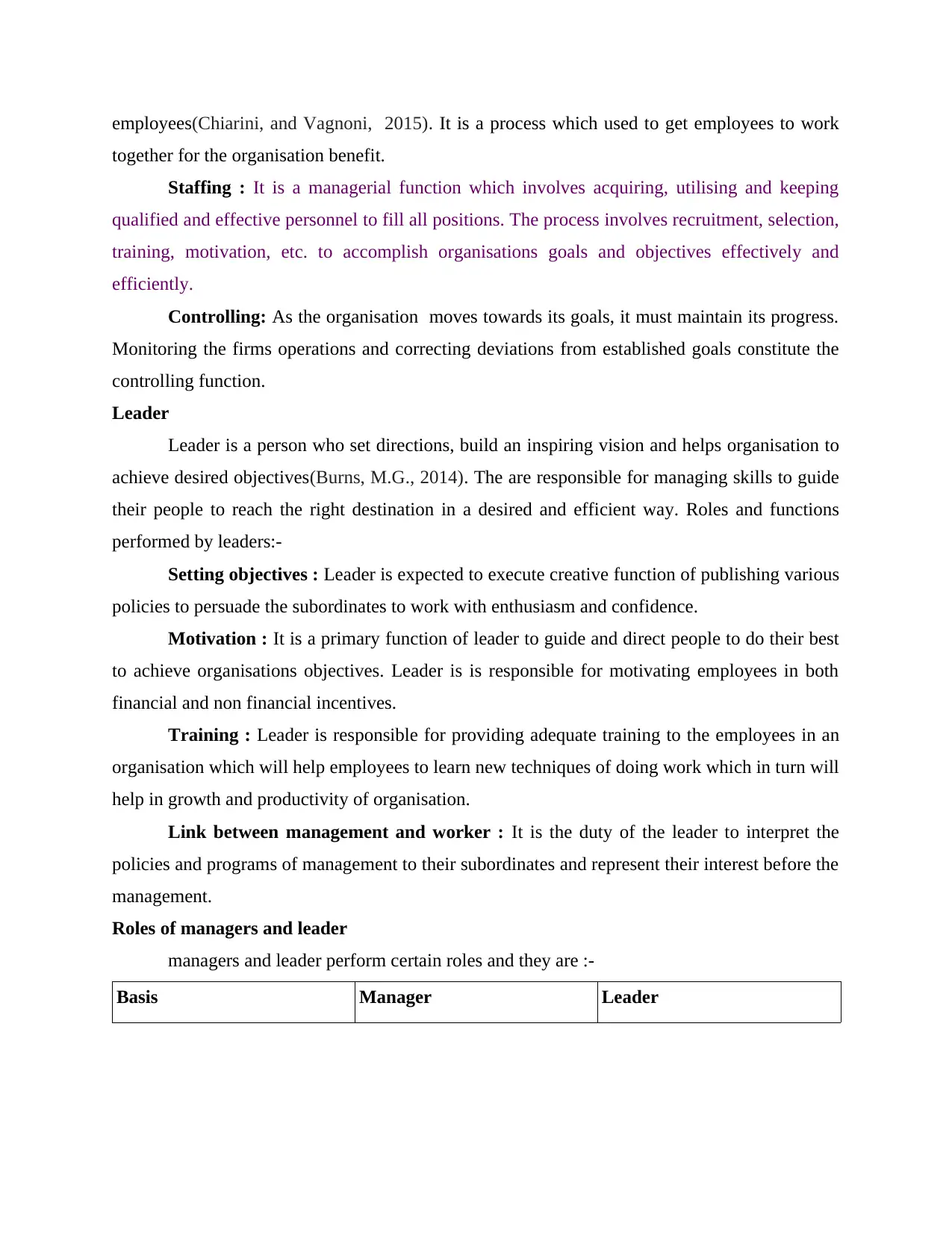
employees(Chiarini, and Vagnoni, 2015). It is a process which used to get employees to work
together for the organisation benefit.
Staffing : It is a managerial function which involves acquiring, utilising and keeping
qualified and effective personnel to fill all positions. The process involves recruitment, selection,
training, motivation, etc. to accomplish organisations goals and objectives effectively and
efficiently.
Controlling: As the organisation moves towards its goals, it must maintain its progress.
Monitoring the firms operations and correcting deviations from established goals constitute the
controlling function.
Leader
Leader is a person who set directions, build an inspiring vision and helps organisation to
achieve desired objectives(Burns, M.G., 2014). The are responsible for managing skills to guide
their people to reach the right destination in a desired and efficient way. Roles and functions
performed by leaders:-
Setting objectives : Leader is expected to execute creative function of publishing various
policies to persuade the subordinates to work with enthusiasm and confidence.
Motivation : It is a primary function of leader to guide and direct people to do their best
to achieve organisations objectives. Leader is is responsible for motivating employees in both
financial and non financial incentives.
Training : Leader is responsible for providing adequate training to the employees in an
organisation which will help employees to learn new techniques of doing work which in turn will
help in growth and productivity of organisation.
Link between management and worker : It is the duty of the leader to interpret the
policies and programs of management to their subordinates and represent their interest before the
management.
Roles of managers and leader
managers and leader perform certain roles and they are :-
Basis Manager Leader
together for the organisation benefit.
Staffing : It is a managerial function which involves acquiring, utilising and keeping
qualified and effective personnel to fill all positions. The process involves recruitment, selection,
training, motivation, etc. to accomplish organisations goals and objectives effectively and
efficiently.
Controlling: As the organisation moves towards its goals, it must maintain its progress.
Monitoring the firms operations and correcting deviations from established goals constitute the
controlling function.
Leader
Leader is a person who set directions, build an inspiring vision and helps organisation to
achieve desired objectives(Burns, M.G., 2014). The are responsible for managing skills to guide
their people to reach the right destination in a desired and efficient way. Roles and functions
performed by leaders:-
Setting objectives : Leader is expected to execute creative function of publishing various
policies to persuade the subordinates to work with enthusiasm and confidence.
Motivation : It is a primary function of leader to guide and direct people to do their best
to achieve organisations objectives. Leader is is responsible for motivating employees in both
financial and non financial incentives.
Training : Leader is responsible for providing adequate training to the employees in an
organisation which will help employees to learn new techniques of doing work which in turn will
help in growth and productivity of organisation.
Link between management and worker : It is the duty of the leader to interpret the
policies and programs of management to their subordinates and represent their interest before the
management.
Roles of managers and leader
managers and leader perform certain roles and they are :-
Basis Manager Leader
Paraphrase This Document
Need a fresh take? Get an instant paraphrase of this document with our AI Paraphraser

Planning It plans the policies and
programs for entire
organisation.
It follows the plans made by
manager for entire
organisation.
Recruiting and training It is responsible for hiring and
firing employees in an
organisation.
It is responsible for guiding
and providing training to the
employees.
Risk It controls and minimises the
risk in the organisation.
It initiate risk in the
organisation.
Difference between manager and leader
Managers and leaders are different from each other in many ways such as :-
Basis Manager Leader
Focus Their focus is in managing
work.
Their focus is in managing
people.
Style Transactional Transformational
Risk It minimises risk in the
organisation.
It takes risk in the organisation
.
Orientation They are always process
oriented.
They are vision oriented and
thinks about future.
Similarity between leader and manager
Leaders and managers do have similarities as primary motive of both of them is to
achieve organisational goals effectively and efficiently(Rose, P.S. and Hudgins, S.C., 2012).
They both needs group to work for what they want to do. They influence the work structure and
environment. They both create the foundation for organisation and functional structure. Their
main concern is to allocate available resources such that they can be used effectively and
efficiently. Following depicts the similarities of both manager and leader :-
Basis Leader and managers
Work for goal They both work for common goal of achieving
programs for entire
organisation.
It follows the plans made by
manager for entire
organisation.
Recruiting and training It is responsible for hiring and
firing employees in an
organisation.
It is responsible for guiding
and providing training to the
employees.
Risk It controls and minimises the
risk in the organisation.
It initiate risk in the
organisation.
Difference between manager and leader
Managers and leaders are different from each other in many ways such as :-
Basis Manager Leader
Focus Their focus is in managing
work.
Their focus is in managing
people.
Style Transactional Transformational
Risk It minimises risk in the
organisation.
It takes risk in the organisation
.
Orientation They are always process
oriented.
They are vision oriented and
thinks about future.
Similarity between leader and manager
Leaders and managers do have similarities as primary motive of both of them is to
achieve organisational goals effectively and efficiently(Rose, P.S. and Hudgins, S.C., 2012).
They both needs group to work for what they want to do. They influence the work structure and
environment. They both create the foundation for organisation and functional structure. Their
main concern is to allocate available resources such that they can be used effectively and
efficiently. Following depicts the similarities of both manager and leader :-
Basis Leader and managers
Work for goal They both work for common goal of achieving
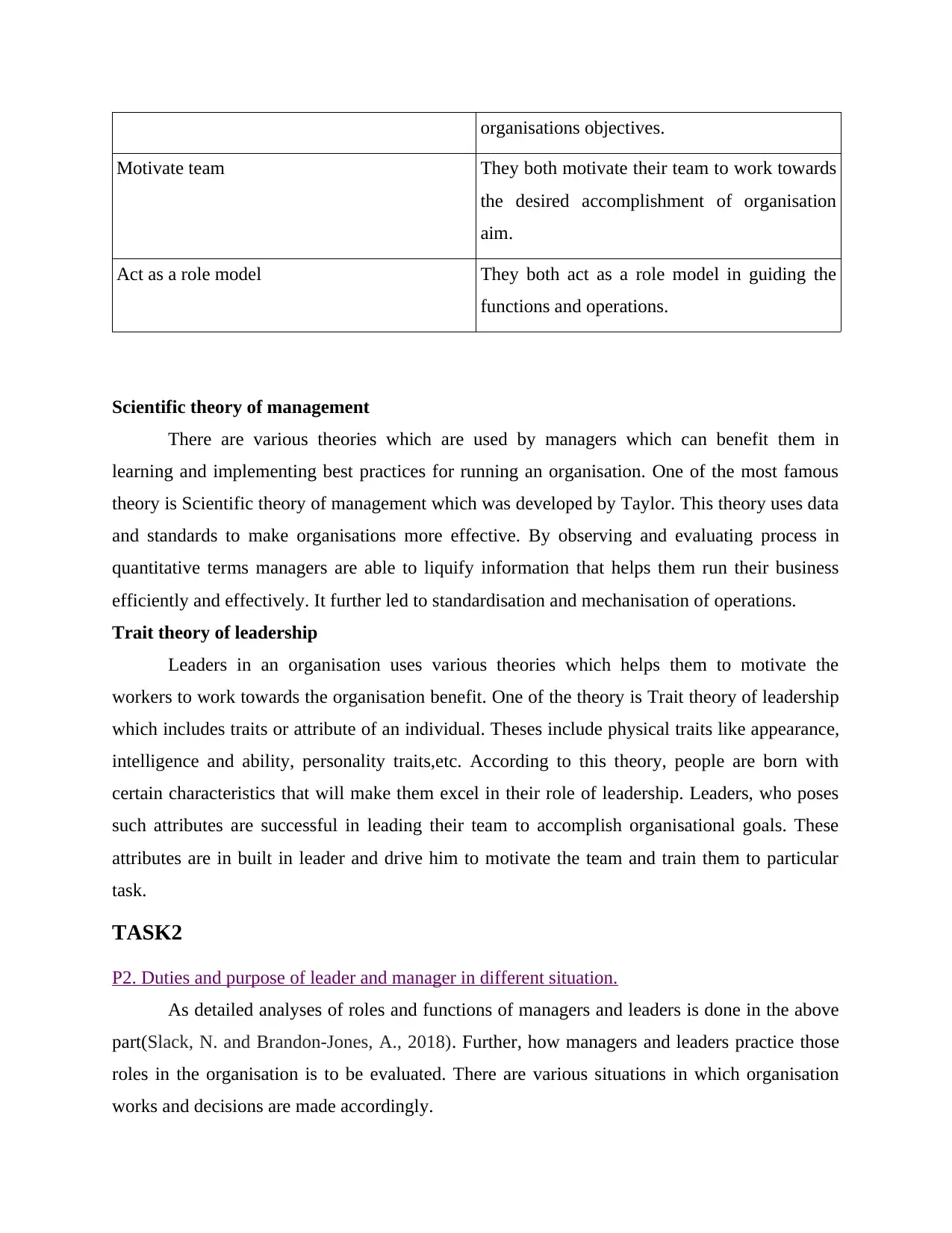
organisations objectives.
Motivate team They both motivate their team to work towards
the desired accomplishment of organisation
aim.
Act as a role model They both act as a role model in guiding the
functions and operations.
Scientific theory of management
There are various theories which are used by managers which can benefit them in
learning and implementing best practices for running an organisation. One of the most famous
theory is Scientific theory of management which was developed by Taylor. This theory uses data
and standards to make organisations more effective. By observing and evaluating process in
quantitative terms managers are able to liquify information that helps them run their business
efficiently and effectively. It further led to standardisation and mechanisation of operations.
Trait theory of leadership
Leaders in an organisation uses various theories which helps them to motivate the
workers to work towards the organisation benefit. One of the theory is Trait theory of leadership
which includes traits or attribute of an individual. Theses include physical traits like appearance,
intelligence and ability, personality traits,etc. According to this theory, people are born with
certain characteristics that will make them excel in their role of leadership. Leaders, who poses
such attributes are successful in leading their team to accomplish organisational goals. These
attributes are in built in leader and drive him to motivate the team and train them to particular
task.
TASK2
P2. Duties and purpose of leader and manager in different situation.
As detailed analyses of roles and functions of managers and leaders is done in the above
part(Slack, N. and Brandon-Jones, A., 2018). Further, how managers and leaders practice those
roles in the organisation is to be evaluated. There are various situations in which organisation
works and decisions are made accordingly.
Motivate team They both motivate their team to work towards
the desired accomplishment of organisation
aim.
Act as a role model They both act as a role model in guiding the
functions and operations.
Scientific theory of management
There are various theories which are used by managers which can benefit them in
learning and implementing best practices for running an organisation. One of the most famous
theory is Scientific theory of management which was developed by Taylor. This theory uses data
and standards to make organisations more effective. By observing and evaluating process in
quantitative terms managers are able to liquify information that helps them run their business
efficiently and effectively. It further led to standardisation and mechanisation of operations.
Trait theory of leadership
Leaders in an organisation uses various theories which helps them to motivate the
workers to work towards the organisation benefit. One of the theory is Trait theory of leadership
which includes traits or attribute of an individual. Theses include physical traits like appearance,
intelligence and ability, personality traits,etc. According to this theory, people are born with
certain characteristics that will make them excel in their role of leadership. Leaders, who poses
such attributes are successful in leading their team to accomplish organisational goals. These
attributes are in built in leader and drive him to motivate the team and train them to particular
task.
TASK2
P2. Duties and purpose of leader and manager in different situation.
As detailed analyses of roles and functions of managers and leaders is done in the above
part(Slack, N. and Brandon-Jones, A., 2018). Further, how managers and leaders practice those
roles in the organisation is to be evaluated. There are various situations in which organisation
works and decisions are made accordingly.
⊘ This is a preview!⊘
Do you want full access?
Subscribe today to unlock all pages.

Trusted by 1+ million students worldwide
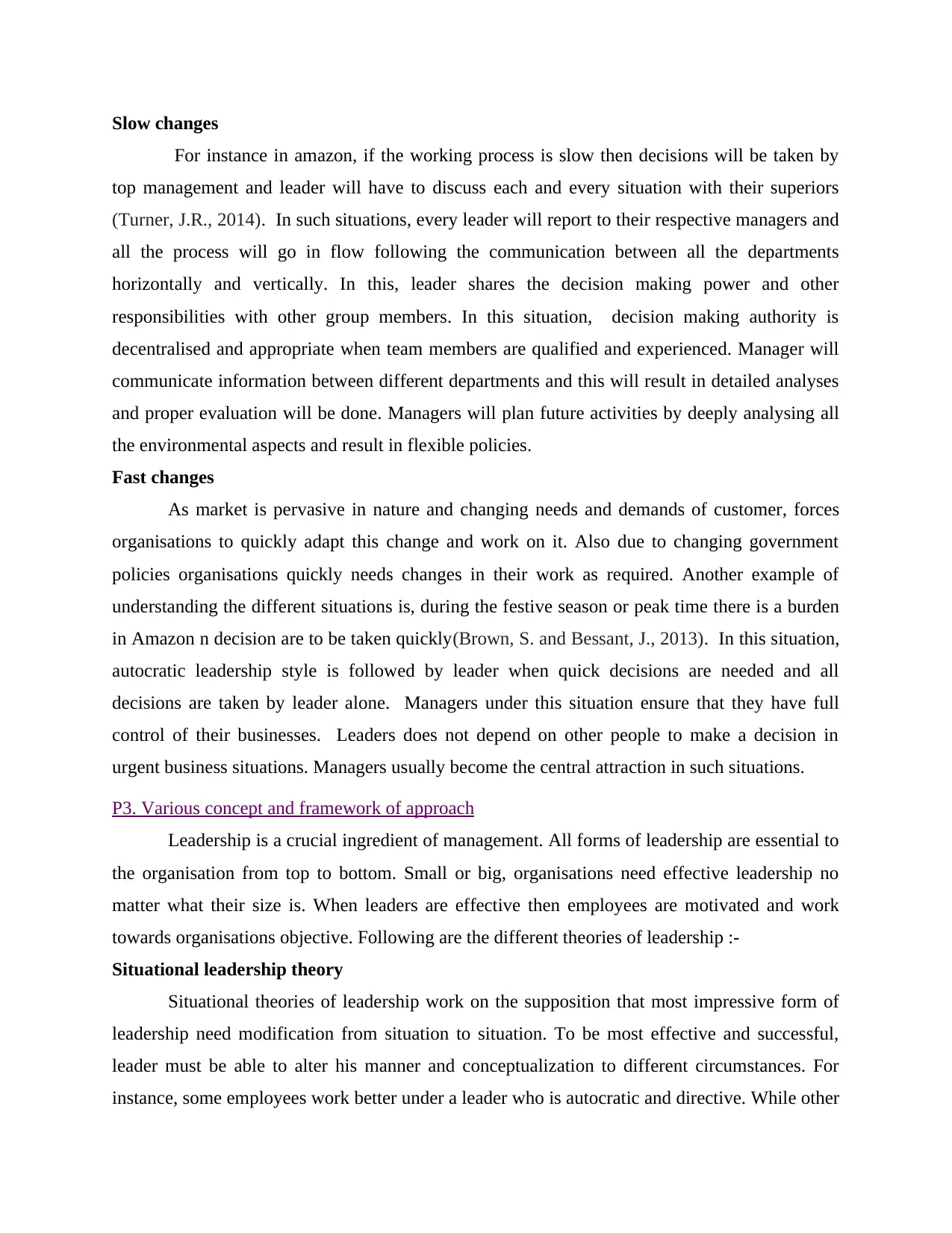
Slow changes
For instance in amazon, if the working process is slow then decisions will be taken by
top management and leader will have to discuss each and every situation with their superiors
(Turner, J.R., 2014). In such situations, every leader will report to their respective managers and
all the process will go in flow following the communication between all the departments
horizontally and vertically. In this, leader shares the decision making power and other
responsibilities with other group members. In this situation, decision making authority is
decentralised and appropriate when team members are qualified and experienced. Manager will
communicate information between different departments and this will result in detailed analyses
and proper evaluation will be done. Managers will plan future activities by deeply analysing all
the environmental aspects and result in flexible policies.
Fast changes
As market is pervasive in nature and changing needs and demands of customer, forces
organisations to quickly adapt this change and work on it. Also due to changing government
policies organisations quickly needs changes in their work as required. Another example of
understanding the different situations is, during the festive season or peak time there is a burden
in Amazon n decision are to be taken quickly(Brown, S. and Bessant, J., 2013). In this situation,
autocratic leadership style is followed by leader when quick decisions are needed and all
decisions are taken by leader alone. Managers under this situation ensure that they have full
control of their businesses. Leaders does not depend on other people to make a decision in
urgent business situations. Managers usually become the central attraction in such situations.
P3. Various concept and framework of approach
Leadership is a crucial ingredient of management. All forms of leadership are essential to
the organisation from top to bottom. Small or big, organisations need effective leadership no
matter what their size is. When leaders are effective then employees are motivated and work
towards organisations objective. Following are the different theories of leadership :-
Situational leadership theory
Situational theories of leadership work on the supposition that most impressive form of
leadership need modification from situation to situation. To be most effective and successful,
leader must be able to alter his manner and conceptualization to different circumstances. For
instance, some employees work better under a leader who is autocratic and directive. While other
For instance in amazon, if the working process is slow then decisions will be taken by
top management and leader will have to discuss each and every situation with their superiors
(Turner, J.R., 2014). In such situations, every leader will report to their respective managers and
all the process will go in flow following the communication between all the departments
horizontally and vertically. In this, leader shares the decision making power and other
responsibilities with other group members. In this situation, decision making authority is
decentralised and appropriate when team members are qualified and experienced. Manager will
communicate information between different departments and this will result in detailed analyses
and proper evaluation will be done. Managers will plan future activities by deeply analysing all
the environmental aspects and result in flexible policies.
Fast changes
As market is pervasive in nature and changing needs and demands of customer, forces
organisations to quickly adapt this change and work on it. Also due to changing government
policies organisations quickly needs changes in their work as required. Another example of
understanding the different situations is, during the festive season or peak time there is a burden
in Amazon n decision are to be taken quickly(Brown, S. and Bessant, J., 2013). In this situation,
autocratic leadership style is followed by leader when quick decisions are needed and all
decisions are taken by leader alone. Managers under this situation ensure that they have full
control of their businesses. Leaders does not depend on other people to make a decision in
urgent business situations. Managers usually become the central attraction in such situations.
P3. Various concept and framework of approach
Leadership is a crucial ingredient of management. All forms of leadership are essential to
the organisation from top to bottom. Small or big, organisations need effective leadership no
matter what their size is. When leaders are effective then employees are motivated and work
towards organisations objective. Following are the different theories of leadership :-
Situational leadership theory
Situational theories of leadership work on the supposition that most impressive form of
leadership need modification from situation to situation. To be most effective and successful,
leader must be able to alter his manner and conceptualization to different circumstances. For
instance, some employees work better under a leader who is autocratic and directive. While other
Paraphrase This Document
Need a fresh take? Get an instant paraphrase of this document with our AI Paraphraser
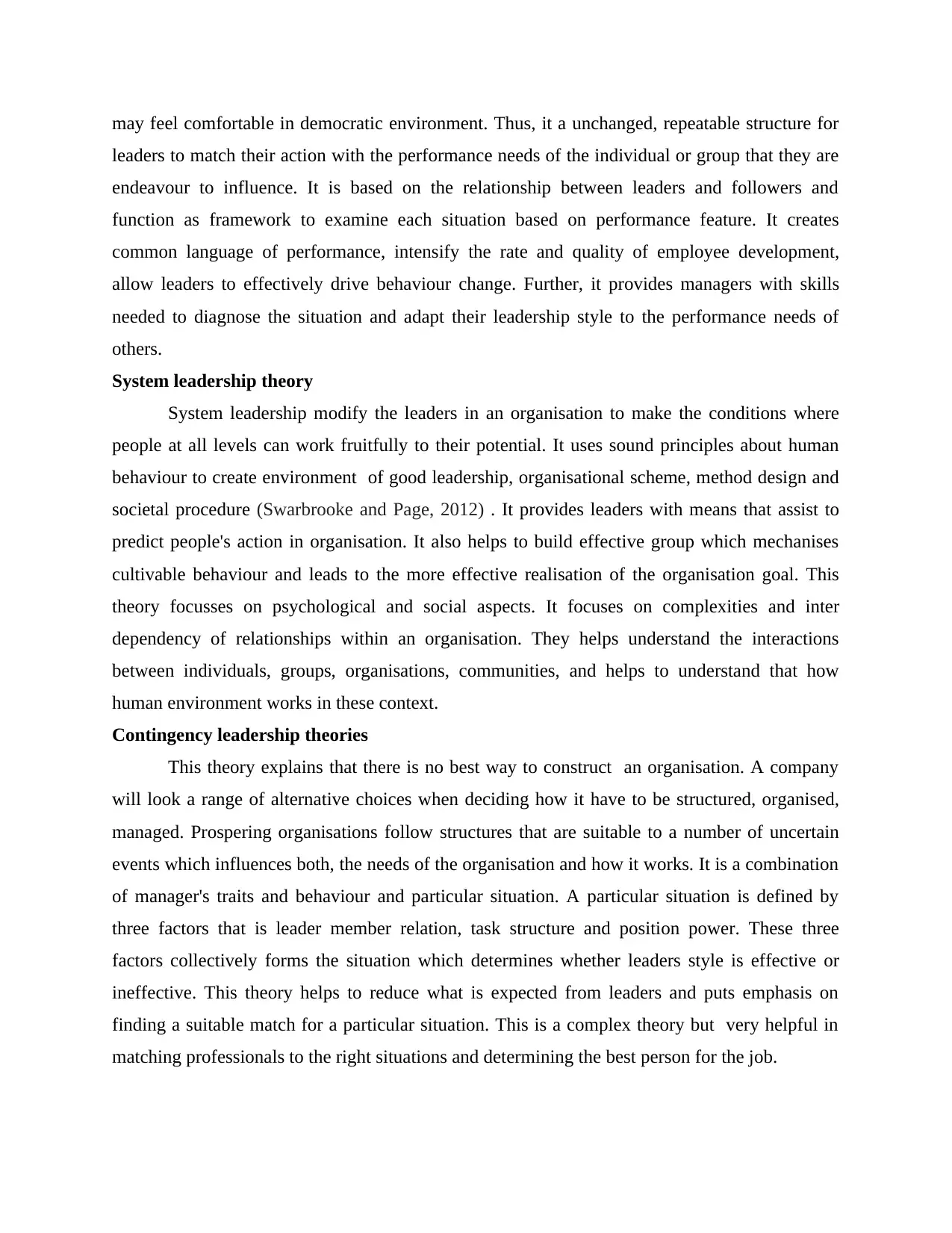
may feel comfortable in democratic environment. Thus, it a unchanged, repeatable structure for
leaders to match their action with the performance needs of the individual or group that they are
endeavour to influence. It is based on the relationship between leaders and followers and
function as framework to examine each situation based on performance feature. It creates
common language of performance, intensify the rate and quality of employee development,
allow leaders to effectively drive behaviour change. Further, it provides managers with skills
needed to diagnose the situation and adapt their leadership style to the performance needs of
others.
System leadership theory
System leadership modify the leaders in an organisation to make the conditions where
people at all levels can work fruitfully to their potential. It uses sound principles about human
behaviour to create environment of good leadership, organisational scheme, method design and
societal procedure (Swarbrooke and Page, 2012) . It provides leaders with means that assist to
predict people's action in organisation. It also helps to build effective group which mechanises
cultivable behaviour and leads to the more effective realisation of the organisation goal. This
theory focusses on psychological and social aspects. It focuses on complexities and inter
dependency of relationships within an organisation. They helps understand the interactions
between individuals, groups, organisations, communities, and helps to understand that how
human environment works in these context.
Contingency leadership theories
This theory explains that there is no best way to construct an organisation. A company
will look a range of alternative choices when deciding how it have to be structured, organised,
managed. Prospering organisations follow structures that are suitable to a number of uncertain
events which influences both, the needs of the organisation and how it works. It is a combination
of manager's traits and behaviour and particular situation. A particular situation is defined by
three factors that is leader member relation, task structure and position power. These three
factors collectively forms the situation which determines whether leaders style is effective or
ineffective. This theory helps to reduce what is expected from leaders and puts emphasis on
finding a suitable match for a particular situation. This is a complex theory but very helpful in
matching professionals to the right situations and determining the best person for the job.
leaders to match their action with the performance needs of the individual or group that they are
endeavour to influence. It is based on the relationship between leaders and followers and
function as framework to examine each situation based on performance feature. It creates
common language of performance, intensify the rate and quality of employee development,
allow leaders to effectively drive behaviour change. Further, it provides managers with skills
needed to diagnose the situation and adapt their leadership style to the performance needs of
others.
System leadership theory
System leadership modify the leaders in an organisation to make the conditions where
people at all levels can work fruitfully to their potential. It uses sound principles about human
behaviour to create environment of good leadership, organisational scheme, method design and
societal procedure (Swarbrooke and Page, 2012) . It provides leaders with means that assist to
predict people's action in organisation. It also helps to build effective group which mechanises
cultivable behaviour and leads to the more effective realisation of the organisation goal. This
theory focusses on psychological and social aspects. It focuses on complexities and inter
dependency of relationships within an organisation. They helps understand the interactions
between individuals, groups, organisations, communities, and helps to understand that how
human environment works in these context.
Contingency leadership theories
This theory explains that there is no best way to construct an organisation. A company
will look a range of alternative choices when deciding how it have to be structured, organised,
managed. Prospering organisations follow structures that are suitable to a number of uncertain
events which influences both, the needs of the organisation and how it works. It is a combination
of manager's traits and behaviour and particular situation. A particular situation is defined by
three factors that is leader member relation, task structure and position power. These three
factors collectively forms the situation which determines whether leaders style is effective or
ineffective. This theory helps to reduce what is expected from leaders and puts emphasis on
finding a suitable match for a particular situation. This is a complex theory but very helpful in
matching professionals to the right situations and determining the best person for the job.

TASK 3 & TASK 4
Covered in PPT
CONCLUSION
From the above analysis of leader and manger of amazon, the operational management
activity can effect the role of leader and manager. So, company need to understand that the
operational activity have to be managed in a right way. If the situation change the style of
leadership have to be changes because in every situation the leader can't apply the same style.
Amazon operational activities are different from other companies because they don't produce any
goods. They just sell the products which company buys. The external environment effects the
business in numerous ways. As,they are MNC so for them doing PESTLE analysis is essential.
Covered in PPT
CONCLUSION
From the above analysis of leader and manger of amazon, the operational management
activity can effect the role of leader and manager. So, company need to understand that the
operational activity have to be managed in a right way. If the situation change the style of
leadership have to be changes because in every situation the leader can't apply the same style.
Amazon operational activities are different from other companies because they don't produce any
goods. They just sell the products which company buys. The external environment effects the
business in numerous ways. As,they are MNC so for them doing PESTLE analysis is essential.
⊘ This is a preview!⊘
Do you want full access?
Subscribe today to unlock all pages.

Trusted by 1+ million students worldwide

1 out of 10
Related Documents
Your All-in-One AI-Powered Toolkit for Academic Success.
+13062052269
info@desklib.com
Available 24*7 on WhatsApp / Email
![[object Object]](/_next/static/media/star-bottom.7253800d.svg)
Unlock your academic potential
Copyright © 2020–2025 A2Z Services. All Rights Reserved. Developed and managed by ZUCOL.





